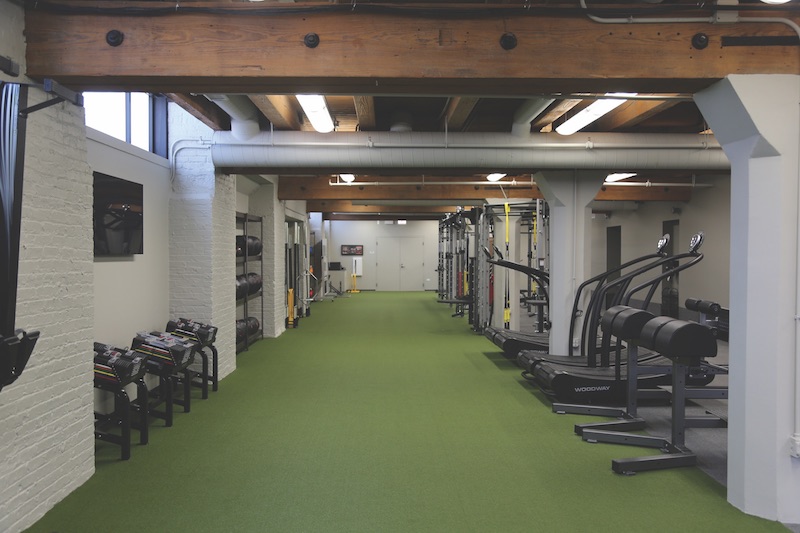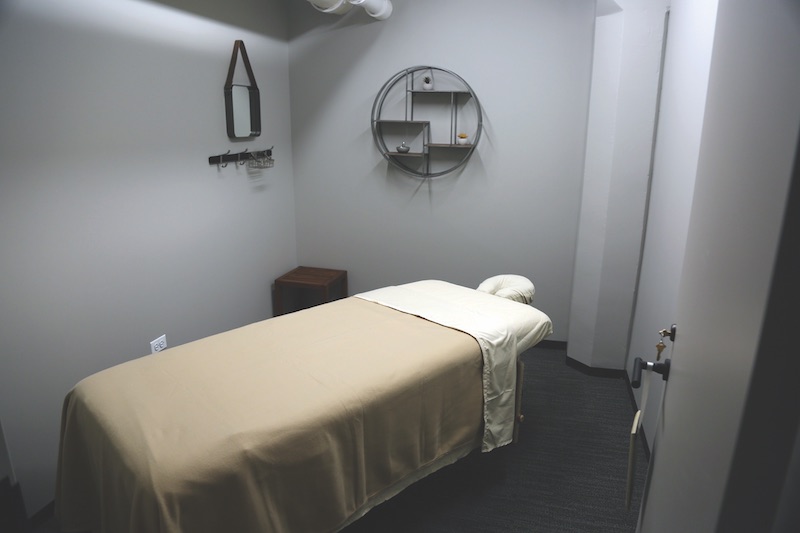The latest trend in integrated healthcare and wellness is the emergence of facilities that track and enhance human performance at the intersection of medicine, fitness, nutrition, and recovery.
At least one startup, Chicago-based Shift, is testing the public’s fervor for one-stop-shop services that combine to minimize acute and chronic pain, illness, and disease by encouraging everyday healthy living.
Until recently, human performance has mostly been the province of professional sports teams. For example, Perkins+Will has designed the 300,000-sf, nine-story sports therapy and research center that, when completed in early 2018, will be part of the Dallas Cowboys’ 91-acre headquarters campus in Frisco, Texas. The center—a collaboration among the Cowboys, healthcare provider Baylor Scott & White, and Blue Star Sports—will include surgical, emergency care, training, and rehabilitation services.
So-called “human performance facilities” are finding their way onto college campuses, too. In the summer of 2018, McNeese State University, Lake Charles, La., is scheduled to open its $41 million Health and Human Performance Education Complex.
Richard Rhodan, the university’s Director of Facilities and Plant Operations, says the 145,000-sf facility—designed by Crawford Architects and Randy M. Goodloe Architect, and built by Alfred Palma LLC—will set aside 22,000 sf for classrooms, labs, and offices for the college’s health and human performance program, whose enrollment has increased by 20% since 2010. Another 8,500 sf feet will be shared space, where students get hands-on training in hydrotherapy, kinesiology, and other sports-related recovery procedures.
In a recent blog on BD+C’s website (www.BDCnetwork.com/JWilliamsBlog), Jennifer Williams, an Interior Designer with P+W, observed that human performance facilities for “common folk” are popping up around the country. These facilities combine diagnostic and clinical services with “performance centers” that rely on technology and coaching to help individuals and teams reach their optimum health and fitness levels.
 Courtesy Shift.
Courtesy Shift.
In Chicago, Shift—a two-floor, 14,000-sf facility, which opened on February 15—focuses on prevention and quality of life through medical, nutrition, fitness, coaching, and recovery programs that get members directly involved in their own healthy choices and courses of action. Membership ranges from $3,000 to $8,000 annually for three tiers of health and wellness plans:
- Shift Life helps members define their health goals and create habits for healthy living. This level includes a yearly physical and 12 months of direct primary medical care, plus access to the facility’s amenities and equipment.
- Shift Extension offers all of the Shift Life services, but targets Chicagoans who travel a lot and probably won’t use the facility as their primary place of fitness and recovery. These members have access to virtual coaching sessions. Extension members also have access to a primary care physician within the facility, and a one-day-per-month pass for fitness and recovery activities.
- Shift Primary Care provides high-quality, easily accessible personalized medical care. The facility’s medical staff strives to build a long-term relationship with members.
 Courtesy Shift.
Courtesy Shift.
“Coaching is at the heart of the Shift experience,” says Dr. Ari Levy, Shift’s Founder and CEO, an internal medicine specialist who has experience as a personal trainer and nutritionist.
His conception of Shift can be traced to his college days, when, he says, “I noticed that the fitness and medical worlds weren’t necessarily coming together. Today, we know more than ever about how the mind and body work, yet we still have chronic diseases.”
Levy says that his real estate and project team partners—notably CBRE, CannonDesign, and the DiCosola Group—were instrumental in developing Shift’s design. “We helped them organize Shift’s spaces because they weren’t exactly sure what the overall tone would be,” says Robert Benson, Principal/Design Leader in CannonDesign's Chicago office.
What Levy wanted was smooth design transitions from room to room within the facility. For example, the entrance and café on the top floor needed to be “warm and inviting,” with glass doors, translucent walls, and a reclaimed wood table that conveyed “a presence of comfort.”
A 26-foot-long, 13-foot-wide staircase, whose steps are covered with a turf and rubber motif, leads to the facility’s medical offices, which Levy describes as “safe and secure, but not clinical.”
“Ari’s idea is, ‘How can we treat people who are healthy?’” says Benson, a BD+C 40 Under 40 honoree. “This is an incredible opportunity for them, and I’m surprised something like this hasn’t happened sooner.”
 Courtesy Shift.
Courtesy Shift.
Related Stories
Lighting | Mar 4, 2024
Illuminating your path to energy efficiency
Design Collaborative's Kelsey Rowe, PE, CLD, shares some tools, resources, and next steps to guide you through the process of lighting design.
MFPRO+ News | Mar 1, 2024
Housing affordability, speed of construction are top of mind for multifamily architecture and construction firms
The 2023 Multifamily Giants get creative to solve the affordability crisis, while helping their developer clients build faster and more economically.
Multifamily Housing | Feb 29, 2024
Manny Gonzalez, FAIA, inducted into Best in American Living Awards Hall of Fame
Manny Gonzalez, FAIA, has been inducted into the BALA Hall of Fame.
K-12 Schools | Feb 29, 2024
Average age of U.S. school buildings is just under 50 years
The average age of a main instructional school building in the United States is 49 years, according to a survey by the National Center for Education Statistics (NCES). About 38% of schools were built before 1970. Roughly half of the schools surveyed have undergone a major building renovation or addition.
MFPRO+ Research | Feb 28, 2024
New download: BD+C's 2023 Multifamily Amenities report
New research from Building Design+Construction and Multifamily Pro+ highlights the 127 top amenities that developers, property owners, architects, contractors, and builders are providing in today’s apartment, condominium, student housing, and senior living communities.
AEC Tech | Feb 28, 2024
How to harness LIDAR and BIM technology for precise building data, equipment needs
By following the Scan to Point Cloud + Point Cloud to BIM process, organizations can leverage the power of LIDAR and BIM technology at the same time. This optimizes the documentation of existing building conditions, functions, and equipment needs as a current condition and as a starting point for future physical plant expansion projects.
Data Centers | Feb 28, 2024
What’s next for data center design in 2024
Nuclear power, direct-to-chip liquid cooling, and data centers as learning destinations are among the emerging design trends in the data center sector, according to Scott Hays, Sector Leader, Sustainable Design, with HED.
Windows and Doors | Feb 28, 2024
DOE launches $2 million prize to advance cost-effective, energy-efficient commercial windows
The U.S. Department of Energy launched the American-Made Building Envelope Innovation Prize—Secondary Glazing Systems. The program will offer up to $2 million to encourage production of high-performance, cost-effective commercial windows.
AEC Innovators | Feb 28, 2024
How Suffolk Construction identifies ConTech and PropTech startups for investment, adoption
Contractor giant Suffolk Construction has invested in 27 ConTech and PropTech companies since 2019 through its Suffolk Technologies venture capital firm. Parker Mundt, Suffolk Technologies’ Vice President–Platforms, recently spoke with Building Design+Construction about his company’s investment strategy.
Performing Arts Centers | Feb 27, 2024
Frank Gehry-designed expansion of the Colburn School performing arts center set to break ground
In April, the Colburn School, an institute for music and dance education and performance, will break ground on a 100,000-sf expansion designed by architect Frank Gehry. Located in downtown Los Angeles, the performing arts center will join the neighboring Walt Disney Concert Hall and The Grand by Gehry, forming the largest concentration of Gehry-designed buildings in the world.
















